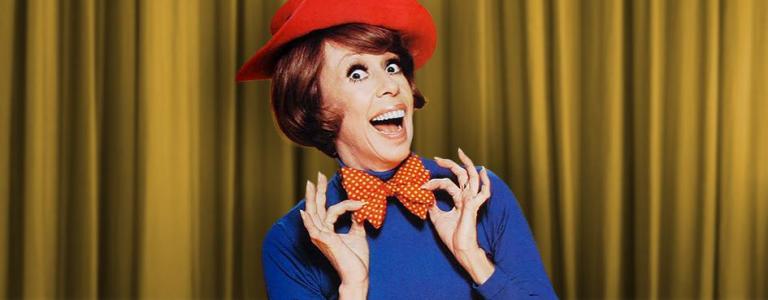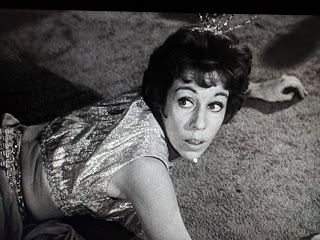
Biography: Never Afraid to Fail
Carol Creighton Burnett was born in San Antonio, Texas in 1933 (1).
Burnett spent the majority of her childhood living in Hollywood, California. She initially moved there Santa Monica to live with her parents, but was sent to live with her grandmother (Nanny) and great-grandmother (Goggy) after her father’s alcoholism worsened and her mother physically attacked him. Later, when her parents split up, Burnett moved to Hollywood with her mother and Nanny. While Burnett’s mother and Nanny often fought about money and alcohol, Carol characterizes her childhood as positive (1).
Burnett’s family was impacted by the Great Depression and depended on President Roosevelt’s Works Progress Administration (WPA) program for things like clothing and food. Burnett’s mother wanted to interview and write about movie stars for a living, but had trouble landing a steady writing position. What little extra money Burnett’s family had was spent on going to the movies, an investment that Burnett later credited for sparking her interest in acting (1).
Burnett’s first job was as an usherette at the Warner Brothers Theater in Hollywood. She was fired for not seating moviegoers who came in during the last few minutes of a show, an offense so egregious to her manager that he ripped off part of her uniform. Years later, when Burnett was awarded a star on Hollywood’s Walk of Fame, she requested that it be placed directly in front of the same theater she was fired from (1).
 While Burnett often practiced acting as various characters with her friends, her first experience with performing came in ninth grade when she played a maid named Musie- a role she picked because it didn’t require physical beauty and had “the best lines.” Unfortunately, she could not pick drama as an area of study in high school, because the school’s drama teacher quit. Instead, she chose to major in Spanish (1).
While Burnett often practiced acting as various characters with her friends, her first experience with performing came in ninth grade when she played a maid named Musie- a role she picked because it didn’t require physical beauty and had “the best lines.” Unfortunately, she could not pick drama as an area of study in high school, because the school’s drama teacher quit. Instead, she chose to major in Spanish (1).
Pictured: Burnett’s senior photo from Hollywood High School in 1950
After being accepted into UCLA, Burnett faced the problem of paying the 42 dollar tuition. The cost was too high for her family to pay, but Burnett remained optimistic that she would be able to register. Then, one day, an envelope containing 50 dollars appeared in the Burnett family mailbox. The envelope had no return address, and Burnett would never find out who paid for her college education (1).
While Burnett’s mother wanted her to be a reporter, Burnett felt a burning desire to become an actress. She decided to become a Theater Arts major at UCLA. In her first acting class, she was asked to perform a dramatic role and received a D minus from her teacher, who didn’t give her an F only because she memorized her lines. From then on, she decided to stick to comedic roles (1).
“I had nowhere to go but up.” – Burnett on why she stayed in the theater program after she initially failed (1)
At UCLA, Burnett tried out for every student-written one-act play, eventually landing a role as a hillbilly in Keep Me a Woman Grown. When she got laughs from the audience for her performance, she knew acting was the career for her.
“Happy. Happiness. That’s what it was. Bliss. I never wanted to lose it. And I knew that for the rest of my life I would keep sticking my chin out no matter what, to see if I could ever feel that way again.” – Burnett on the feeling of getting her first laugh (1)
During her second semester at UCLA, Burnett landed a singing role in a production of Guys and Dolls. She played the character Adelaide, who sings about having a cold. Feeling that she could play the character since her singing voice didn’t have to be “pretty,” Burnett gave it her all onstage and was met with a standing ovation. At the end of the semester, she was named “Most Outstanding Newcomer,” (1).
Burnett continued performing in musical comedies at UCLA but soon pined for the acting possibilities in New York City. Though she did not have the money to move, she claims to have known she would somehow end up there. The kindness of others once again pushed Burnett to the next level when a rich man agreed to pay for her way to the big city. The man, whose identity Burnett promised to never reveal, gave her one thousand dollars and made her promise to use her future success to help others (1).
When she got to New York City, Burnett found a place to live at The Rehearsal Club, a low-cost home for aspiring actresses. She worked part-time as a hat-check girl, sharing her shift with another actress. After being rejected and ignored at many Broadway auditions, Burnett met with a talent agent who could only offer her the advice to put on her own show to attract the attention of casting directors. After discussing the idea with the women of The Rehearsal Club, Burnett put together The First Annual Rehearsal Club Review. The show was a hit, and Burnett soon signed with the William Morris agency (1).
With the help of the agency, Burnett soon landed a job as an entertainer at a resort called Green Mansions. By December of 1955, she was performing on television for the first time on a NBC children’s show headed by Paul Winchell. The job lasted for thirteen weeks, and Burnett soon landed a job at a show called Stanley. After that, she landed a guest spot on The Garry Moore Show, where she was so popular that she was invited to come back any time she had new material. She also appeared on The Ed Sullivan Show in 1957. Though things were looking up for Burnett, she was paid very little during this time and still collected unemployment every week (1).
Burnett continued to gain attention for her comedic and musical style, and was offered a spot in an off-Broadway of Once Upon a Mattress. The show was so successful that it ended up running on Broadway for a year. After that, she continued appearing on The Garry Moore Show, showcasing her comedic style (1). She also appeared as a guest in various other shows in the early sixties, including a major role in the “Cavender is Coming” episode of The Twilight Zone in 1962. 
Pictured: a shot of Burnett from “Cavender is Coming”
Burnett’s comedic style involved slapstick comedy, humorous voices, and strong facial expressions. Her loud voice, which she would sometimes use to scream like Tarzan, contributed to her comedic performances as well. She describes her acting style as “goofy and zany,” which she believes was the reason she was put on television (2). Though she was a female comedian at a time where women were considered inferior to men, she still performed in sketches where she played strong female roles, such as this Super Girl sketch from The Garry Moore Show.
 Pictured: a promotional image for The Carol Burnett Show
Pictured: a promotional image for The Carol Burnett Show
In 1967, The Carol Burnett Show premiered on CBS. It was the first variety show to be hosted by a woman, making television history. The show featured an opening segment where Burnett spoke with the audience, comedy sketches, musical numbers, and guest stars. Burnett created several recurring characters on the show, such as Eunice and Ed, a working-class married couple (seen below). In the show, Burnett was able to explore the limitations that gender norms place upon women, as seen in the following clip. The show won multiple Emmys and stayed on the air until 1979. At the end of each episode, Burnett would tug her ear, a signal to her Nanny (1, 3).
After The Carol Burnett Show, Burnett appeared in various roles, both comedic  and dramatic, on television, Broadway, and in film. She published several books, including One More Time: A Memoir. Her most recent work is a Netflix show called A Little Help with Carol Burnett, where children offer advice (3).
and dramatic, on television, Broadway, and in film. She published several books, including One More Time: A Memoir. Her most recent work is a Netflix show called A Little Help with Carol Burnett, where children offer advice (3).
Burnett has been critically recognized for her work, winning twenty five Emmys, a Tony nomination, a Peabody Award, a Presidential Medal of Freedom, and the Kennedy Center’s Mark Twain Prize for Humor.
Pictured: Burnett receiving the Mark Twain Prize for Humor
Burnett’s Experiences as a Woman in Comedy:
Burnett, like many female comics, faced sexism in the entertainment industry. She often speaks about how, when she pitched The Carol Burnett Show to CBS’s vice president, he said that “variety is a man’s game.” Because of a clause in her CBS contract, Burnett was able to create the show, but not before typical male bullshit tried to get in her way (4).
Impacts and Influences:
Because she was the first female variety show host on television, Carol Burnett was a major trailblazer for women in comedy television. Burnett is often credited with bringing women into the world of sketch comedy, with comics like Tina Fey and Amy Poehler calling her a major influence (5).
Carol Burnett and Feminism:
Though Burnett initially did not consider herself a feminist, she started calling herself one when she learned about the Equal Rights Amendment from Alan Alda. Though she was never openly political in her work, she often spent time working to help pass the ERA (2).
Though she does not prefer to be political in her comedy, some of Burnett’s characters on The Carol Burnett Show dealt with themes such as the constraints caused by gender roles. An example of this can be seen in The Family video linked in the biography section of this page.
While Burnett believes that female comics like Tina Fey would still be around if The Carol Burnett Show never aired, I disagree. Burnett showed that women could be funny in a variety of roles all in the space of one show, a concept that had never been introduced to the media before. In opening the door for female sketch comics, she allowed for a new generation of women in comedy to flourish. That’s pretty darn feminist if you ask me.
Works Cited:
(1) Burnett, Carol. One More Time: a Memoir. Random House Trade Paperbacks, 2003.
(2) “Carol Burnett.” PBS, Public Broadcasting Service, 24 July 2015, http://www.pbs.org/wnet/americanmasters/carol-burnett-the-carol-burnett-interview/90/
(3) Brennan, John Vincent. “Carol Burnett.” Encyclopædia Britannica, Encyclopædia Britannica, Inc., 13 Feb. 2019, http://www.britannica.com/biography/Carol-Burnett.
(4) DeCaro, Frank. “Carol Burnett Talks About Her Show and a New Award.” The New York Times, The New York Times, 21 Dec. 2017, http://www.nytimes.com/2015/09/10/arts/television/carol-burnett-talks-about-her-show-and-a-new-award.html?_r=0.
(5) Boyle, Katherine. “Carol Burnett Awarded the Mark Twain Prize for American Humor at the Kennedy Center.” The Washington Post, WP Company, 20 Oct. 2013, http://www.washingtonpost.com/lifestyle/style/carol-burnett-awarded-the-mark-twain-prize-for-american-humor-at-the-kennedy-center/2013/10/20/3a801504-3832-11e3-80c6-7e6dd8d22d8f_story.html?utm_term=.faeae8ee6c3f.
(Photo One Credit: https://www.metv.com/shows/carol-burnett-and-friends)
(Photo Two Credit: https://abcnews.go.com/Entertainment/photos/carol-burnett-life-pictures-44572528/image-46602529)
(Photo Three Credit: http://twilightzonevortex.blogspot.com/2018/01/cavender-is-coming.html)
(Photo Four Credit: https://www.imdb.com/title/tt0061240/mediaviewer/rm2379185920)
(Photo Five Credit: https://abcnews.go.com/Entertainment/photos/photo-46871773)
